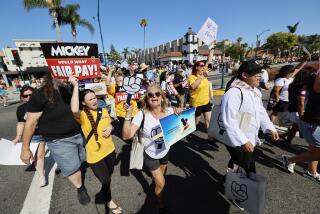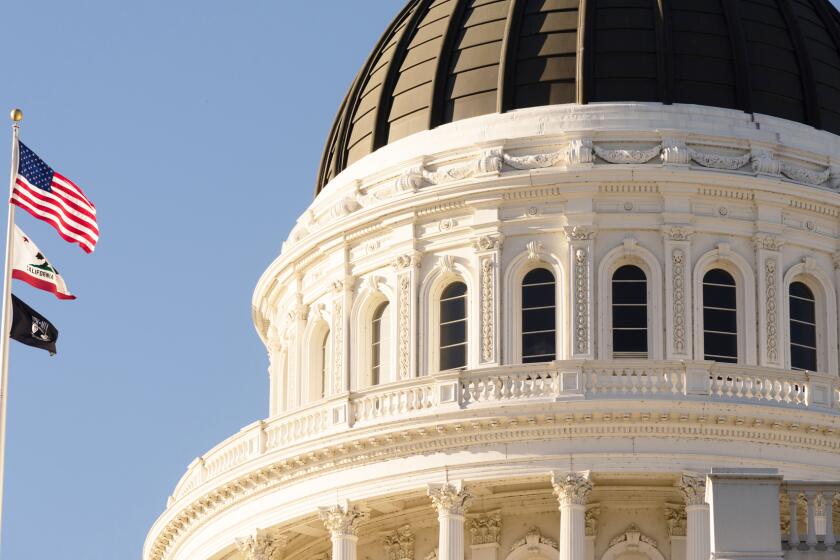Wilson OKs $60 Million in Disney Aid : Transportation: The governor pledges state funds for parking garage, two freeway ramps to Disneyland Resort. He says ‘major employment’ will be worth expense.
Citing “enormous” economic and employment benefits for the state, Gov. Pete Wilson pledged his support for the proposed Disneyland Resort on Wednesday, committing $60 million for two freeway ramps and a massive parking garage.
Wilson said the state is getting involved in the Disney venture because it gives “the promise of major employment” and would help the state recover from recession.
“The magnitude of the economic benefits of this project are difficult to overestimate,” Wilson said. “It is worthy of the kind of team effort being made at all levels, the state as well.”
After meeting privately with officials from the Walt Disney Co., Anaheim and Orange County about the project, Wilson publicly announced the funds at a press conference with Disneyland President Jack Lindquist.
Wilson said the project will help fill the demand for jobs that has occurred because of the region’s growing population. “Orange County . . . is never again going to be a sleepy, quiet village. We have been discovered,” Wilson said at the Disneyland Hotel.
The state’s contribution would come from “savings” in other transportation projects, the governor said. State officials said they have identified about $25 million of that. All of the money, Wilson added, is committed by law for transportation purposes and would not impact the state’s general fund.
Wilson traveled to Orange County Wednesday to discuss the entertainment giant’s ambitious $3-billion plan that includes a new theme park next to Disneyland, several hotels, a 5,000-seat amphitheater, and a shopping district in what is now a run-down urban setting.
For months, Disney and Anaheim officials have been trying to win financial commitments from the state to help pay for massive public works improvements, particularly for freeway ramps and one of two mammoth parking structures to serve the resort.
Throughout negotiations with state officials, Disney and Anaheim representatives have highlighted the resort’s benefits: that it will create up to 28,000 jobs and $90 million in annual revenue for the state by the year 2008.
Of the $60 million that Wilson pledged to the project, $25 million will pay part of the $50-million cost of two high-occupancy-vehicle off-ramps and $35 million will go toward a $203-million parking garage, which will be used for guests of the Disneyland Resort as well as for commuters who will park there to meet buses, commuter vans and car pools.
About half a dozen local homeowners opposed to the project picketed Wednesday outside the Disneyland Hotel, carrying signs that read: “Stop Disney Greed.”
“It seems a little odd that in these times of fiscal restraint and budget crisis that the state can scrape up enough money for a for-profit enterprise,” said Steve White, one of the protesters. “It really seems out of tune with what’s going on.”
Disney and city officials were pleased with the state’s financial support.
“We said from the beginning that this project was going to be bigger than Disney,” said Lindquist. “We wouldn’t be where we are today without the help of the state and the city. . . . There are many hurdles in the future, but I’m more optimistic today than ever. I believe it’s going to happen.”
Anaheim City Manager James D. Ruth praised the governor’s personal interest in the project.
“It would be a disaster statewide if this project did not go forward,” Ruth said. “I think the governor recognizes that. The state can’t afford for it not to be built.”
Despite the state’s contribution, Disney officials cautioned that they still need further support from federal and city governments to make the project financially feasible. The entertainment giant, which earned $816 million last year, is asking for about $800 million in public funding for public works and other improvements in the Disneyland area.
Disney and the city of Anaheim are negotiating a development agreement that will detail how much the city will contribute to the project. Disney would pay some $2.2 billion to build the entertainment and hotel aspects of the resort.
In June, the City Council approved the environmental and planning documents covering the project. Several nearby property owners and school districts, who believe the resort’s impacts were not fully considered, have said they intend to sue.
In committing state money to the private venture, Wilson said that the “most significant thing that we can do to improve the lives of Californians is to put the million or so who have lost their jobs during this recession back to work.”
“We are going to have to see new jobs created by new ideas, or services or products, and this fits that definition big time,” he said.
For Wilson, the visit to Orange County offered a chance to dole out some good news amid the state’s dogged economic recession and earn a spot on evening newscasts as he begins the long struggle for reelection. Although the election is more than a year away, Wilson’s job rating has suffered in most polls, and he has seized every opportunity in recent weeks to capture positive media attention.
While the governor was pitching the $60 million worth of funding as a boon for the Disneyland project, officials at Caltrans were taking pains to stress that the ramps and commuter parking center would benefit the entire community.
The state transportation agency and Disneyland have been debating for several years just how the freeway ramps should be configured. Disney initially was pushing for ramps that led almost directly into the parking structure planned at the theme park, but Caltrans officials have historically been reluctant to fund projects that give even an appearance of benefiting a single business.
As now configured, the ramps would feed cars from the freeway’s high-occupancy lanes onto overpasses at West and Freeman streets, which are adjacent to Disneyland.
Brent Felker, Caltrans deputy district director in Orange County for project management, said the ramps would handle anticipated traffic generated by other businesses in the area, as well as the resort.
“Our drive is to keep people moving,” Felker said. “Our intention is to deal with traffic demands.”
As yet, Caltrans officials have not identified where all of the state funds will come from, he said.
Thomas F. Sayles, Wilson’s secretary of business, transportation and housing, said the state’s $25-million share of the ramp project will come from already identified savings in other road projects.
As now envisioned, the rest of the $60 million is to be culled from savings in a variety of Caltrans projects that are expected to come in under budget, officials said.
In the past few years, Caltrans has enjoyed a tremendous savings on projects in Orange County and throughout the state. With the economy floundering, construction companies have flocked to bid on state freeway work, helping to drive down costs for Caltrans. In addition, California’s flagging real estate market has lowered the price tag for right-of-way purchases along freeways.
A potential obstacle might come from Orange County itself, one legislative official in Sacramento said. If residents complain that other transportation projects in the county are more deserving of the $60 million, state and local officials could be hard pressed to justify spending the excess funds on the improvements near Disneyland.
In recent years, elected officials in South County have griped that too much transportation money is being spent in the north part of the county. But it remained unclear Wednesday whether that simmering north-south feud might boil over into the Disney deal. “That’s the only kink I can see that might develop,” the Sacramento official said.
More to Read
Sign up for Essential California
The most important California stories and recommendations in your inbox every morning.
You may occasionally receive promotional content from the Los Angeles Times.






